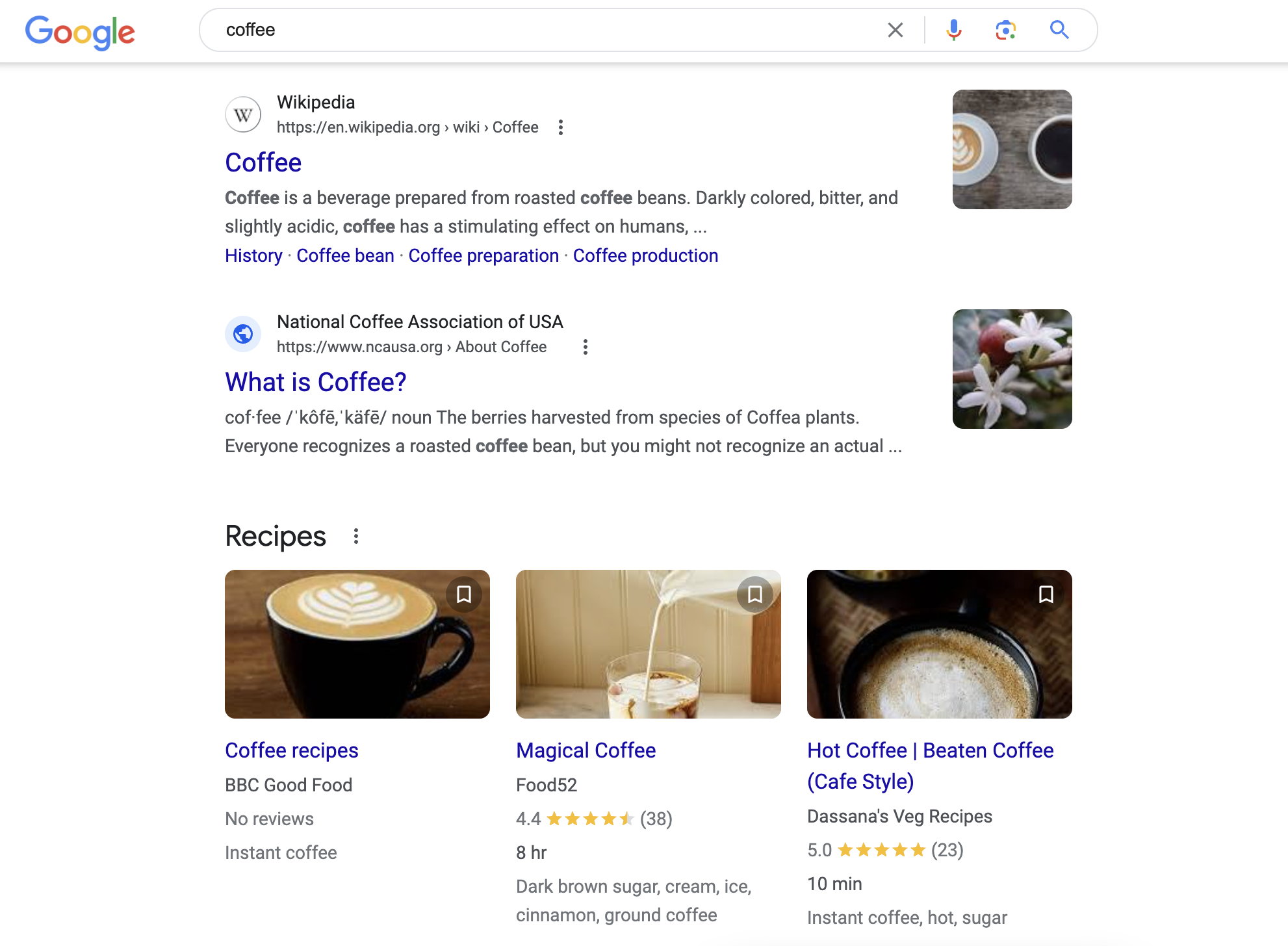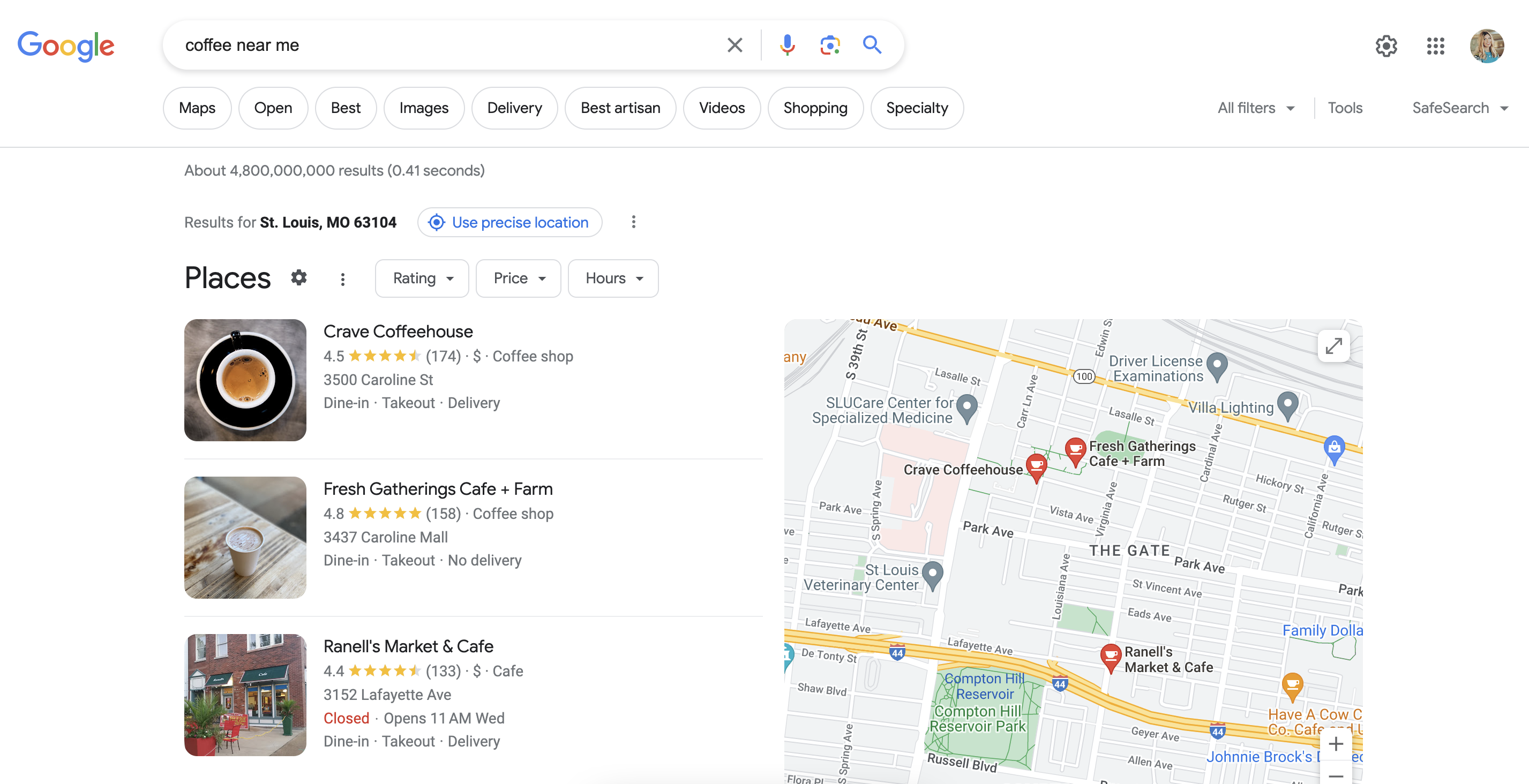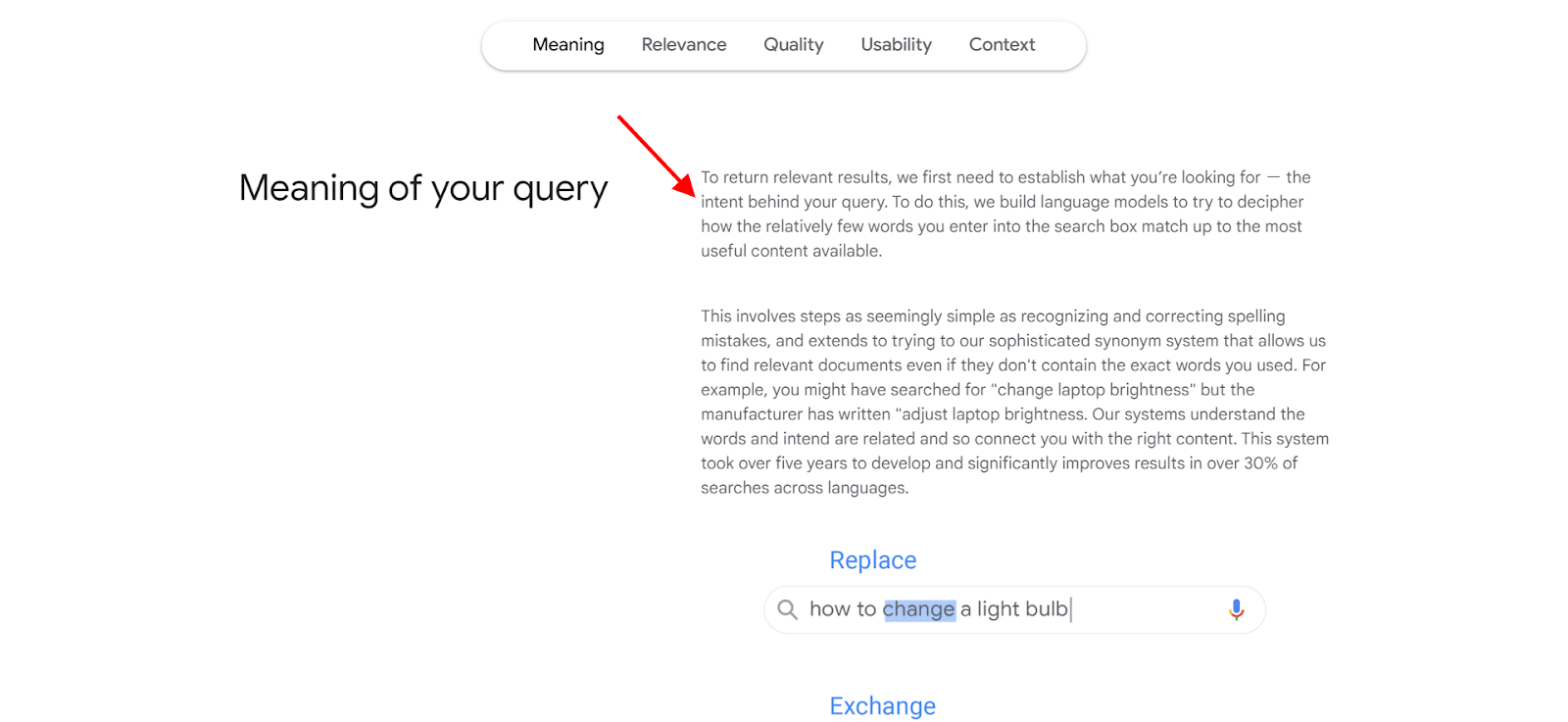The quality of a search engine depends on how often it returns relevant results for a given search query. It’s not surprising, therefore, that search engines like Google really prioritize understanding “search intent” or “keyword intent” behind a search so they can serve the most relevant results.
This keen understanding of what a user is looking for at the time of a search is what separates the quality of SERPS (search engine result pages) Bing serves from what Google serves. The more relevant an algorithm’s understanding of the search intent behind a query, the better the results a search engine can produce, resulting in more users for that search engine.

Because “keyword intent” is so important for Google, website owners who want to get more online traffic or rankings need to win favors with the search engine by helping it serve the end-users with the right type of results.
So, how can SEOs and marketers incorporate keyword intent into their SEO and content strategy? Let’s get right into it.
What is Keyword Intent?
Keyword intent, also known as search intent, is a fundamental concept in Search Engine Optimization (SEO). It is the purpose behind a user’s online search query.
Keyword intent goes beyond the words a person types into a search engine. It also encompasses the outcome they hope to achieve.
For example, if a person searches for “coffee” on a search engine like Google, they could be hoping to achieve one of the few objectives:
- Looking to purchase coffee online from an e-commerce store
- Searching for coffee shops near them in their area
- Looking to understand what coffee is, what its history is, etc.
- Looking for benefits/disadvantages of coffee
Because all of these could be possible “intents” behind a non-specific general search like “coffee” — Google actually serves up all these different results.

What happens when we get more specific with our search? Does the user intent change? Let’s find out.
Let’s try “coffee near me”. This search intent is likely from someone who has GPS enabled on their search device and wants to know the nearest place they could get their coffee fix.
You’ll notice how not only the types of search results shown are vastly different, but because this search is location-specific i.e. “an area near me” — it shows mostly map results versus informational results. This is how search engines work to deliver the most accurate information you need at the time you need it.

Types of Keyword Intent
Broadly speaking, there are four types of keyword intent. Each keyword can serve either one or multiple search intents.
- Informational Intent:
Users want to learn, understand, or explore a topic. Types of search queries that have an informational connotation include searches like, “How to do XYZ”, or “What is XYZ”.
- Navigational Intent:
This is about finding a specific page from a website, like typing in “LinkedIn login” to reach the LinkedIn login page directly or searching for “Facebook support” to go directly to their support desk.
- Transactional Intent: Keywords that signal an intent to purchase/subscribe. Example: Buy XYZ phone online, Las Vegas to LA flights, kitchen remodeling consultation, cleaning service quotes.
- Commercial Investigation Intent: Users want to research products or services before making a purchase decision. They compare options, read reviews, and weigh the pros and cons.
Examples include queries like, “Best phones for senior citizens”, “iPhone 11 reviews”, “Spotify vs Youtube Music”, “Honda City 2023 reviews” etc.
Understanding these intents is critical, as they indicate how you must craft your content and call-to-actions (CTAs). Your content must align with the user’s expectations to be effective.
How Does Keyword Intent Relate to Buyer Journey?
Keyword intent is closely related to how primed a user is to act, i.e. solve a problem by hiring or making a purchase. When they are looking for information or researching, they know they have a problem – but they don’t necessarily know what solutions exist to help them. And remember, all purchases are made when the purchase provides a solution to a person’s problem.
Let’s take for example, “How can I remove grease stains from my stove?”. At this stage, they just want information. You can suggest different products that can solve their problem too (they’re problem-aware, but not solution-aware).
As this person progresses into a Commercial investigation and/or Transactional intent stage, they’d have already figured out that there are solutions to their problem, such as cleaning products and cleaning services that can help them remove those stains.
Now, by serving up the right content at that stage that convinces them your product is better than other products out there, you can convince them to buy from you.
Aligning keyword intent with buyer journey, therefore, serves the end goal of converting a user from “just browsing about my problems” stage to “Because you helped me figure out how to solve my problems— I trust you know how to solve that problem for me, so why don’t you just solve it for me?” stage.

Why Does Keyword Intent Matter in SEO?
Understanding keyword intent is like having a roadmap or compass to guide you through your SEO strategy and mapping out content that satisfies buyers at each stage of their journey, as per the marketing funnel. Here’s why keyword intent matters in SEO:
1. Enhances the User Experience by Delivering Relevant Content
Imagine you’re searching for “how to cook pasta.” Your intent is to find quick solutions to cook pasta at home.
If you click on a search result that takes you to a page selling pasta, you’ll feel frustrated and leave the site. The resulting content doesn’t match your intent, leading to a poor user experience. However, if the search results provide articles or videos with step-by-step instructions on cooking pasta, you’ll find the content valuable and stay on the page.
Here, keyword intent is aligned with the content, creating a positive user experience.
Search engines study the behaviors of users who land on a page to determine if that page adequately serves their search intent — and if too many people repeatedly leave that page to look for a solution elsewhere, Google may change its position in the SERPs for that search query.
Remember, their ultimate goal is to be the best search engine for their user— and if a page they ranked repeatedly doesn’t deliver what their users want to see with a particular search query, it’s time to go.
2. Increases Click-Through Rates (CTR) and Reduces Bounce Rates
Let’s consider a search for “best digital cameras”
If your website offers a comprehensive guide comparing the top digital cameras, users searching for this term are more likely to click on your link. They’re more likely to engage with your content.
On the flip side, if your site primarily sells digital cameras and your page ranks for this informational query, users who click through may quickly bounce back to the search results because they didn’t find the information they were seeking.
This high bounce rate can negatively impact your SEO efforts.
3. Boosts Organic Rankings by Aligning with Search Engine Algorithms
Search engines aim to deliver the most relevant results to users. They consider user behavior, including click-through rates and bounce rates, to determine the quality of a page.
When your content aligns with keyword intent and keeps users engaged, search engines are more likely to view your page favorably and rank it higher.
4. Drives Qualified Organic Traffic and Potential Conversions
When your content matches the intent of user queries, it attracts visitors genuinely interested in your offerings, leading to higher conversion rates.
Whether it’s transactional content guiding users to make a purchase or informational content establishing your authority, aligning with keyword intent ensures better-quality traffic and improved conversion outcomes.
Consider a user searching for “best running shoes for beginners”
If your website offers a well-researched article on this topic and includes affiliate links to recommended products, you’re likely to attract visitors genuinely interested in buying running shoes.
These users are not just browsing; they have commercial intent. By aligning your content with their intent, you increase the likelihood of conversions.
5. Adapts to Changing Search Trends and User Behaviors
Search trends evolve over time. For example, in recent years, there has been a surge in voice searches with queries like “What’s the weather today?” or “Find the nearest pizza place.”
Understanding these changing search behaviors and adapting your content to cater to the intent behind voice searches can help you stay relevant and visible in search results.
6. Helps You to Create a Content Strategy for All Stages of the Buying Funnel
Consider a user searching for “best budget smartphones.” This query suggests they are in the research phase, comparing options before making a purchase.
Providing a well-structured guide or comparison of budget smartphones can capture their attention and help them make an informed decision.
Conversely, if your content only focuses on selling products, you may miss out on this valuable audience segment.
Tools for Identifying Keyword Intent

Understanding keyword intent is critical for successful SEO. The below list acquaints you with some tools and methods to help you understand it effectively.
A. Utilize Keyword Research Tools
These are the first in your arsenal to uncover keyword intent. They provide insights into how people search and what they are looking for.
- Focus on key markers to organize your keywords, such as words like “how to”, “buy”, or “review”. These will help you categorize keywords in the right categories.
- Another key marker is the Cost Per Click (CPC) of a keyword. Most tools will show you this — and it basically specifies what people are willing to pay for ads for each click related to that keyword. The higher the CPC, the higher the likelihood that the keyword has a transactional intent.
Here’s how to use them:
- Google Keyword Planner: This free tool helps you find keywords related to your topic and provides search volume data. Look for keywords that align with your content’s purpose. CPC is a good indicator here.

- SEMrush: It offers keyword analytics and actually groups keywords into “informational”, “transactional” etc for you.
You can also take advantage of competitive research with SEMRush to discover related keywords and see which ones are driving traffic to your competitors. You can use these insights to see which keywords are going after.

- Ahrefs: Ahrefs provides keyword analysis and insights into the search volume, clicks, and user intent behind specific keywords.

Practical Tip: Look for long-tail keywords (phrases with more words) as they often reveal specific user intent. For example, “best DSLR cameras for beginners” indicates an informational intent — even if your tool doesn’t classify it as such for you.
B. Analyzing Search Engine Results Pages (SERPs)
SERPs are a goldmine of information about keyword intent. When you search for a keyword, pay attention to the types of content that appear on the first page.
- Content Types: When you search for a search query, observe if the first page is dominated by blog posts, product pages, shopping results, map locations, or videos. The dominant content type can give you a clear indication of the search intent behind the keyword.
More blogs typically signal an informational intent, whereas more maps, product pages, or shopping results signal a transactional intent.
- Featured Snippets: If Google features a snippet at the top, it’s a sure way to say that the keyword has an informational intent.
- Related Searches: Scroll down to the bottom of the SERP to find related search queries. These can offer additional insights into user intent.
Practical Tip: Analyze the top-ranking pages to understand how they address the user’s intent. Take notes on their content structure, headings, and the questions they answer. See if there’s a gap you can fill that other people are not addressing. Use it to build content that outranks your competitors.



C. User Surveys and Feedback
Your audience knows their intent better than anyone else. Collecting feedback and conducting surveys can provide valuable insights into what users want when they search.
- Online surveys: Use tools like SurveyMonkey or Google Forms to create surveys asking users about their search behavior and what they expect from content.
- Social media and forums: Engage with your audience on social media platforms and forums relevant to your niche. Ask questions and encourage discussions about their search intent.
Practical Tip: Ask open-ended questions in surveys and discussions to encourage users to describe their intent in their own words. This approach can reveal nuances you might have missed.
Identifying Keyword Intent with Just a Glance
Certain phrases always denote a specific search intent. For instance, Buy + [insert product name] always has a transactional intent.
We have compiled a list of all common phrases used in longtail keywords that can help you identify their intent manually without a tool.
| Keyword/Phrase | Intent |
| Buy | Transactional |
| Purchase | Transactional |
| Order | Transactional |
| Subscribe | Transactional |
| Get a quote | Transactional |
| Pricing | Transactional |
| Free shipping | Transactional |
| Coupon | Transactional |
| Discount | Transactional |
| Review | Commercial Investigation |
| Compare | Commercial Investigation |
| Versus (vs) | Commercial Investigation |
| Best | Commercial Investigation |
| Top | Commercial Investigation |
| Rating | Commercial Investigation |
| Guide | Informational |
| How to | Informational |
| What is | Informational |
| Benefits of | Informational |
| Tips for | Informational |
How Search Engines Interpret Intent
Search engines use a mix of complex algorithms and signals to understand what users want when they type queries into the search bar.
Let’s break down how search engines do this and why it matters in SEO:
- Relevance
This is the foundation of successful SEO.
Search engines assess the relevance of your content to the user’s query. They analyze your webpage’s content, including keywords, headings, and overall topic, to determine if it aligns with what the user is looking for.
When your content is highly relevant to the user’s intent, search engines are more likely to rank it higher in search results.
Practical Tip: Imagine you’re writing a blog post about “healthy breakfast recipes.” To ensure relevance, provide a variety of nutritious breakfast ideas and cooking tips, rather than veering off into unrelated topics like dinner recipes or workout routines. This way, users will find your content valuable and relevant to their needs.
- Click-Through Rate (CTR)
CTR measures how often users click on your search result compared to how often it’s displayed. In other words, it indicates whether your content meets user expectations.
High CTR means users find your content appealing and in line with their intent.
Practical Tip: Craft compelling titles and meta descriptions for your content. For instance, if your article is about “budget travel tips,” your title and description must clearly communicate a summary of budget-friendly advice you offer & why they should trust it.
- Bounce Rate
The bounce rate reflects the percentage of users who land on your page and then quickly leave without engaging further. High bounce rates can suggest that your content doesn’t align with user intent or fails to meet their expectations.
Search engines may interpret this as a mismatch between your content and the user’s intent, potentially affecting your rankings.
Practical Tip: Ensure your content fulfills its promise. If your page is about “home gardening for beginners,” insert practical advice and guidance for novice gardeners. Full-blown selling should be passive at this stage.
- User Experience and Intent
User experience (UX) plays a significant role in how search engines evaluate intent. A positive UX keeps users engaged and satisfied. This, in turn, signals to search engines that your content fulfills the user’s intent effectively.
Practical Tip: Prioritize mobile-friendliness and page load speed. Many users access websites on mobile devices, and slow-loading pages can frustrate them — so if they don’t stick around long enough, search engines may wrongly interpret it as a mismatch of intent.
Ensure that your content is easy to read and navigate on mobile screens. Use clear headings, subheadings, and a user-friendly layout to make your content digestible.
TLDR: Relevance is the starting point; it ensures your content addresses user intent. A high CTR suggests that your content is enticing to users. A low bounce rate indicates that it delivers on their expectations. Providing a seamless user experience reinforces the connection between your content and user intent.
Primary and Secondary Keywords: Establishing a Primary Subject and Topical Relevance
Understanding the distinction between primary and secondary keywords is a fundamental step in crafting a strategic SEO approach.
Learning how to use them effectively can help you strike a balance based on user intent, and create better content.
| Parameter | Primary Keywords | Secondary Keywords |
| Definition | Focal points of content. | Closely related words and supportive keywords. Can also include synonyms of the primary keyword. |
| Role/Purpose | Establish the core subject or main topic. | Add additional context, details, and examples to make the content more relevant for the users. |
| Frequency | Used more frequently. | Used less frequently. |
| User Intent Alignment | Addresses the primary user intent. | Addresses related aspects of user intent. |
| Importance of SEO | Higher importance for rankings. | Provides context and relevance |
| Content Focus | The content revolves around primary keywords. | Secondary keywords add depth to the content |
| Target Audience | Broader audience appeal | Niche or specific audience appeal |
| How It’s Used in a Piece of Content | Appears in the title and main headings of an article. Also appears in the slug/permalink of the article, meta title, & meta description. Important to use in the first and last paragraph of the article | Important to use in subheadingsAlso appears in the main body of the article or FAQs. |
How to Use Primary and Secondary Keywords to Align Your Content with Search Intent
Balance primary and secondary keywords to align your content with user intent. Here’s how to do it effectively:
- Understand what users are searching for when they use your primary keyword.
- Are they seeking information, looking to buy a product, or comparing options? Tailor your content to match the primary keyword’s specific intent.
- Secondary keywords may serve search intents of their own, but you don’t need to tailor your entire content around it. If your primary topic is well covered, you can potentially rank for secondary keywords via the same article too.
- Incorporate secondary keywords naturally within the context of your content.
- For instance, if your primary keyword is “best smartphones“, include secondary keywords like “camera quality comparison” or “battery life reviews” to cater to various user interests.
- Organize your content logically, using headings and subheadings.
- Primary keywords often become main headings. Secondary keywords can be used for subheadings or as part of your content.
Tips for Achieving Search Intent with Your Content:
It is important to assign specific keywords to individual pages or sections of your content. This will help you serve your primary search intent, first and foremost.
- Compile a list of primary and secondary keywords related to your niche.
- Review your existing content to see which keywords are already in use and identify content gaps. Add secondary keywords and related terms to increase topical coverage.
- Match keywords to specific pages or content ideas.
- Ensure that each keyword aligns with the page’s topic and intent.
- Provide the most valuable and relevant information for the chosen keywords.
- Regularly check your content’s performance in search results and user engagement.
- Adjust your keyword assignments as needed to improve rankings and meet user intent more effectively.
How to Incorporate Keyword Intent While Creating a Content Plan [With Examples]
To help you understand how you can start creating different types of content using search intent and primary/secondary keywords, we sorted 20 keywords related to the “insurance” niche as a demonstration.
Each search intent is best served by a specific type of content, so we also mention what kind of content you should create to rank for that particular primary keyword.
| Intent | Primary Keywords | Secondary Keywords | Content Type |
| Informational | How to choose auto insurance | Factors affecting car insurance rates | Blog or Guide |
| Informational | Types of life insurance policies | Term vs. Whole Life Insurance | Blog or Guide |
| Navigational | Geico insurance login | Progressive policy renewal | Website Page |
| Navigational | State Farm insurance contact | Contact Allstate customer support | Website Page |
| Transactional | Get home insurance quote online | Affordable renters insurance options | Landing Page |
| Transactional | Compare health insurance plans | Best family health insurance | Comparison Page |
| Commercial Investigation | Liability vs. Business Owners Policy | Top-rated auto insurance providers | Blog or Comparison Page |
| Commercial Investigation | Insurance for small business | Liability vs Business Owners Policy | Blog or Guide |
| Informational | How to file a car insurance claim | Steps after a car accident | Blog or Guide |
| Transactional | Buy travel insurance for Europe | International travel coverage options | Landing Page |
| Informational | What is a home insurance deductible | Understanding insurance terms | Blog or Guide |
| Navigational | Progressive auto insurance login | Nationwide insurance bill pay | Website Page |
| Commercial Investigation | “Insurance agent vs broker” | “Choosing the right insurance advisor” | Blog or Comparison Page |
| Transactional | “Purchase motorcycle insurance” | “Motorbike coverage options” | Landing Page |
| Commercial Investigation | “Best pet insurance for dogs” | “Coverage comparison for pet insurance” | Blog or Comparison Page |
Tailoring Content to Keyword Intent
Ensuring your content matches user intent is at the heart of effective SEO. Here’s how to craft content that aligns seamlessly with the intent behind the keywords you target:
1. Understand the intent behind your chosen keywords.
- If users are seeking information, your content should educate, inform, and provide answers. Use clear explanations, how-to guides, and informative articles.
- For users looking to make a purchase, guide them through the buying process. Highlight product features, benefits, and calls to action (CTAs) that lead to conversions.
- If users are searching for specific websites or pages, ensure that your content provides good navigation that helps them reach that specific page with minimal clicks. The standard rule is that every page on a website should be accessible within “3 clicks or less”.
In the context of an article, spend some time figuring out pages they would find helpful after reading this particular one. Include clear navigation links and a user-friendly layout.
Here’s an example: Let’s say we have an article for “ChatGPT review”. Other articles that they may find useful here are “Generative Prompts for ChatGPT” or “Utilizing ChatGPT for Your Entire Content Strategy”. Linking to those from the original article will improve navigation around the website, and establish you as an authority in that space.
When users are comparing options, offer in-depth comparisons, reviews, and pros and cons. Help them make informed decisions.
2. Incorporate keywords naturally within your content.
- Use synonyms and related terms instead of repeating the same keyword multiple times to make your content flow smoothly. This not only makes it more reader-friendly but also helps search engines understand how in-depth your content is.
For instance, consider an article about “Beard Styles”. Will it be as in-depth if it fails to mention words like “beard oil” or “beard comb” as part of the content?
Using keyword synonyms, and related keywords helps search engines establish patterns that help your article stand out as an authoritative piece.
- Include variations of your primary and secondary keywords. For instance, if your primary keyword is “healthy recipes”, use variations like “nutritious meal ideas” or “wholesome cooking”.
- Organize your content logically with headings and subheadings that include keywords. This helps users quickly find the information they’re looking for.
3. Put yourself in the shoes of your target audience:
- Anticipate and answer the questions users might have about the topic. Be thorough and provide valuable insights. You can also use tools like Answerthepublic.com to understand what users are looking for.
- Use visuals, bullet points, tables, infographics, and an engaging writing style to make your content appealing.
- Ensure your content is mobile-friendly since many users access the web on smartphones. A responsive design and fast page load times enhance the user experience.
Measuring Success with Keyword Intent

After optimizing your content to align with user intent, you want to be able to measure the success so you can improve the performance of your content even further.
Follow these guidelines on how to gauge the effectiveness of your intent optimization efforts:
- Monitor the number of visitors a specific piece of content attracts from organic search results. An increase in traffic to that URL indicates that your content is ranking well and resonating with users.
- Assess how often users click on your search results. A higher CTR suggests that your content’s title and meta description effectively communicate its relevance to user intent.
- Measure the percentage of users who leave your page without engaging further. A lower bounce rate indicates that users find your content valuable and relevant to their needs.
- Define specific goals for your content, such as sign-ups, purchases, or downloads. These goals should match the intent of the keyword you’re targeting.
If a page has commercial or transactional intent, you may want to track how many users purchase, sign up, or fill out a form after visiting that page.
If a page primarily serves as an informational hub, the goal should be to appear as an authority in that space. Here, measuring “time on page” can be useful.
- If you run an online store, track the number of transactions and revenue generated by users who found your product pages through intent-optimized content.
- If your goal is lead generation, monitor how many users submit contact forms or request more information after reading your content.
- Track aggregate user behavior and compare it with the previous quarter with respect to:
- Time on page: Longer average time spent on your page suggests that users are engaged and finding the content valuable.
- Scroll depth: Analyze how far users scroll down your page. If they read deeper into your content, it indicates a strong match between your content and their intent.
- Navigation patterns: Check if users explore other pages on your website after consuming your content. It can indicate that your content encourages further engagement.
- Search queries: Review the search queries that lead users to your content. If the queries align with your content’s primary and secondary keywords, it’s a sign of successful intent optimization.
Case Studies in Keyword Intent
At this point, you’re probably wondering, “Okay, I get it, search intent is important. But how important is it?”
Let’s see what top SEOs think. In 2019, Surfer conducted a survey featuring the world’s top SEOs like Josh Hardwick, Viola Eva, and Sławek Czajkowski. All of them unanimously agreed that search intent was the most impactful factor in SEO growth.
And it makes sense why. A visit to Google’s “How Search Works” page reveals exactly what Google wants from content.

A case study published by Surfer also directly shows the impact of not aligning with search intent. For an identical dataset of 37,000 SERPs, they monitored how the search intent shifted for those after major Google core updates, including the September 2019 update, the BERT update in October 2019, and the May 2020 update.
They found that there were instances of entire content types being removed from the first page and being replaced by others. The biggest impact was seen in “shopping” searches, which were now full of blogs and commercial investigation pages like reviews and comparisons.
What does that mean for websites that ranked for those SERPs previously? A sink in rankings; and an upheaval battle to redo their content to correct the mismatched search intent.
So to answer the question, how important is search intent today: Very much.
Staying Ahead in SEO: Future Trends in Keyword Intent
SEO is a dynamic field. As search engines become smarter and user behavior changes, so does the importance of understanding keyword intent. Here’s what’s on the horizon:
Voice search dominance:
- Voice search is on the ascent with the rise of voice-activated devices like smart speakers and virtual assistants. Users are now asking conversational questions. Optimizing for voice search requires understanding more natural language and user intent.
- Questions in the “People Also Ask” sections are important to optimize for to win in voice searches.
AI:
- Search engines are increasingly using artificial intelligence to interpret search queries and deliver more relevant results. This means understanding the intent behind keywords will be even more critical.
- Search engines are not just looking at keywords but also the relationships between words and concepts.
- They are getting better at understanding the context of content. Semantic SEO focuses on providing comprehensive, context-rich content that aligns with user intent.
Structured Data:
- Marking up your content with structured data, like Schema.org, helps search engines understand the content’s context and intent better. This can enhance your content’s visibility in rich snippets and featured snippets.
Practical tips for Future-Proofing Your SEO with Search Intent:
- Optimize for long-tail keywords and natural language queries. Users are increasingly using voice search, which tends to be more conversational.
- Focus on high-quality, comprehensive content that thoroughly addresses user intent. In-depth guides and FAQs can help capture featured snippet spots.
- Continually analyze user behavior and adapt your content to match evolving user intent.
- Stay flexible in modifying your content strategy based on data and trends.
- Ensure your content is mobile-friendly. Voice searches often occur on mobile devices, so responsive design is crucial.
- Optimize for local intent if applicable to your business. Users often search for nearby products and services, so ensuring your location information is accurate is essential.
Conclusion: Mastering SEO Keyword Intent for Sustainable Success in SERPs
Keyword intent is the compass that guides content creation in SEO.
By understanding whether users are seeking information, navigation, transactions, or conducting commercial investigations — your SEO strategy can effectively meet their needs.
This user-centric approach benefits not only search engines and users but also sellers, whose goal is to get as many website visitors as possible to convert into actual buyers. Win-win-win!
In an ever-evolving digital landscape marked by voice searches, semantic SEO, and AI, keyword intent remains at the core of sustainable visibility and conversions, driving success across all aspects of the online ecosystem.










